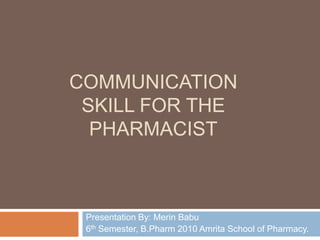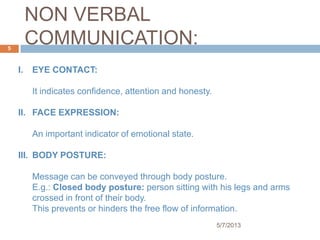Communication skill for the pharmacist
- 1. COMMUNICATION SKILL FOR THE PHARMACIST Presentation By: Merin Babu 6th Semester, B.Pharm 2010 Amrita School of Pharmacy.
- 2. COMMUNICATION SKILL ’é© Communication: The act of imparting news or information or means of connecting places. It is a science and practice of transmitting information. ’é© Communication skill: The ability to communicate clearly and effectively with patients, family members, physicians, nurses, pharmacists and other health care professionals. 5/7/2013 2
- 3. POOR COMMUNICATION ’ü▒ Poor communication skill between pharmacist and patient leads to: -Inaccurate patient medication history -Inappropriate therapeutic decisions -Leads to patient confusion, patient disinterest and patient non-compliance 5/7/2013 3
- 4. TYPES OF COMMUNICATION ’ü▒ There are two types of communication skill: 1. NON-VERBAL COMMUNICATION: 2. VERBAL COMMUNICATION: 5/7/2013 4
- 5. NON VERBAL COMMUNICATION: I. EYE CONTACT: It indicates confidence, attention and honesty. II. FACE EXPRESSION: An important indicator of emotional state. III. BODY POSTURE: Message can be conveyed through body posture. E.g.: Closed body posture: person sitting with his legs and arms crossed in front of their body. This prevents or hinders the free flow of information. 5/7/2013 5
- 6. NON VERBAL COMMUNICATION: Open body posture: A relaxed stance with uncrossed legs and arms. It tends to ease communication. IV. TONE OF VOICE: Soften voice etc can also influence the communication. V. PROXIMITY/CLOSENESS OF POSITION: The pharmacist and patient must maintain a minimum distance of 45cm. VI. ANOTHER FORM OF NON-VERBAL MESSAGE: To convey information through the use of diagrams.5/7/2013 6
- 7. VERBAL COMMUNICATION SKILL Essential verbal communication skills include the: -ability to listen, understand and respond to what people say (active listening) -ability to interpret the non-verbal communication and respond in a way that encourages continued interaction (evaluation). 5/7/2013 7
- 8. VERBAL COMMUNICATION SKILL I. ACTIVE LISTENING: -good listening skill important to promote a good interactive communication and obtain information. -focus on patient, family member or healthcare professional. -make the person feel like CENTRE OF ATTENTION. -have an open, relaxed and unhurried attitude. -set aside all professional interruptions. 5/7/2013 8
- 9. VERBAL COMMUNICATION SKILL - keeping eye contact, nodding, asking questions etc indicate: ATTENTION - tone and modulation of voice, number and placement of pauses: RELIABILTY OF PATIENT PROVIDED INFORMATION. -low level of energy, flat effect, monotone voice: DEPRESSED. 5/7/2013 9
- 10. VERBAL COMMUNICATION SKILL -PAUSES: indicate the person needs time to recall the information or the person is censoring the response or preparing to lie. 2. OBSERVATION AND ASSESSMENT: -Effective two way communication requires: - continual observation - assessment of how the person is communicating - Body language and gestures provide important clues for pharmacist, patient and health care professional. 5/7/2013 10
- 11. VERBAL COMMUNICATION SKILL -SIT OR STAND AT EYE LEVEL: -maintain eye contact -use focussed body posture to convey interest and attentiveness. - OPEN COMMUNICATION: -sitting or standing at eye level or lower projects a non-threatening, equalising body posture. - Physically be close to patient, family member or healthcare professional 5/7/2013 11
- 12. VERBAL COMMUNICATION SKILL 3. LANGUAGE: - For reliable communication; use a language in which both parties are fluent and comfortable. - Abbreviations and terms used for prescribing medicines represent a specialised type of communication. - Do not produce fear, anxiety in patients by saying medical terms. 5/7/2013 12
- 13. 1. COMMUNICATING WITH THE HEALTH PROFESSIONALS: Effective communication between pharmacist and physicians, nurses and other pharmacists is essential. Pharmacist- Physician Communication: ŌĆó Be prepared with specific questions or facts and recommendations when initiating a patient care- related conversation with physicians. 5/7/2013 13
- 14. 2. COMMUNICATION WITH PATIENTS: I. MEDICATION HISTORY INTERVIEW: are required for making decisions. The following information is recorded: 1) Currently or recently prescribed medicines. 2) OTC medicines purchased. 3) Vaccinations 4) Alternative or traditional remedies 5) Description of reactions and allergies to medicines. 6) Medicines found to be ineffective. 5/7/2013 14
- 15. II. PATIENT INFORMATION LEAFLET(PILs): Used to outline key information to assist patients and caregivers in the effective and safe use of medicines. The following information is included: 1.Trade and generic name 2. Indication for which the medicines is being taken. 3.Administrative advice. 4. Information on the action required if dose missed. 5. Common or serious side effects. 5/7/2013 15
- 16. 5/7/2013 16 7. Action to be taken if a side effect is experience. 8. Name and contact details of the institution provided. 9. Author and date of publication the information. III. MEDICATION COUNSELLING FOR PATIENTS: -Effective patient counselling can assist patients in using their medicines safely and reliably. -Before giving information, check the patientŌĆÖs level of understanding. - Advice to patient to adapt the medication regimen to their life style.
- 17. 5/7/2013 17 3. TEACHING: -A teacher must be organised and knowledgeable about the subject being taught and must be an excellent communicator. -Communication is enhanced by good organisational skills. -Direct questioning and assessment of responses are easy ways to determine the responses of students.
- 18. 5/7/2013 18 4. PLATFORM AND POSTER PRESENTATION: PLATFORM PRESENTATION: -Pharmacists make platform presentations at local, state and national professional meetings. POSTER PRESENTATION: -Unique form of communication in which the information is displayed than oral -Posters that attract the most attention have clear, descriptive titles and a colourful, neat professional appearance. -Visual aids like graphs, charts and photographs communicate information effectively.
- 19. 5/7/2013 19 5.MEDIA INTERVIEWS: -Media is an effective form of communication between pharmacist and the public. -Pharmacists are called by the media to provide background information regarding therapeutic issues such as the marketing of an important new drug, drug related problems or the withdrawal of the drug from market.
- 20. 5/7/2013 20 6. MANUSCRIPTS: -Original research reports, case studies, review articles, editorials and letters to the editor are important communication tools among health professionals. -Well written manuscripts that meet the needs of the journalŌĆÖs audience will be published.
- 21. 5/7/201321





















